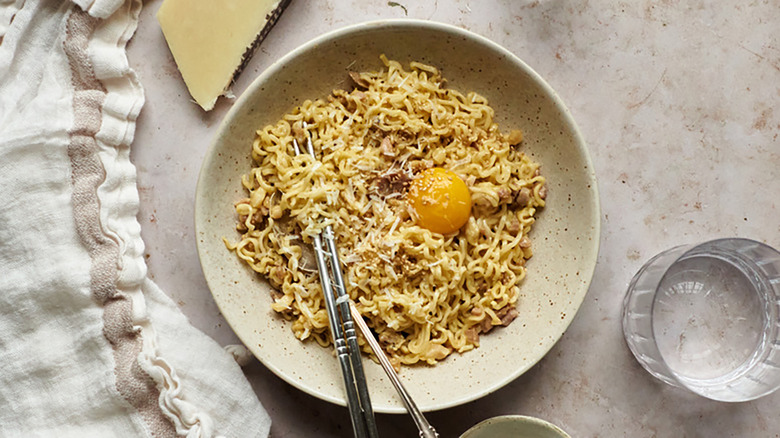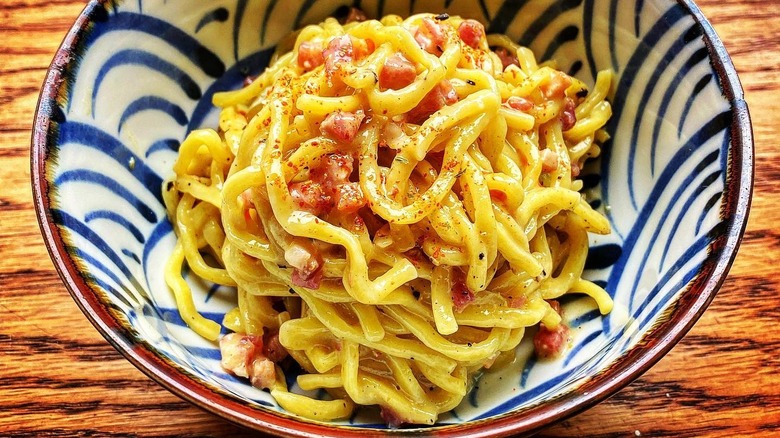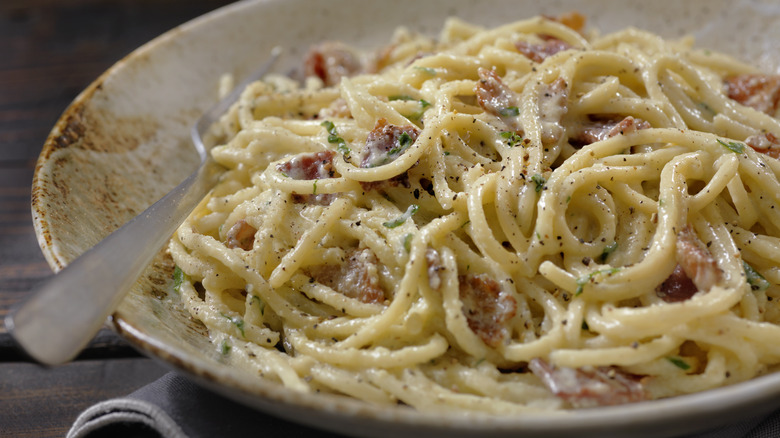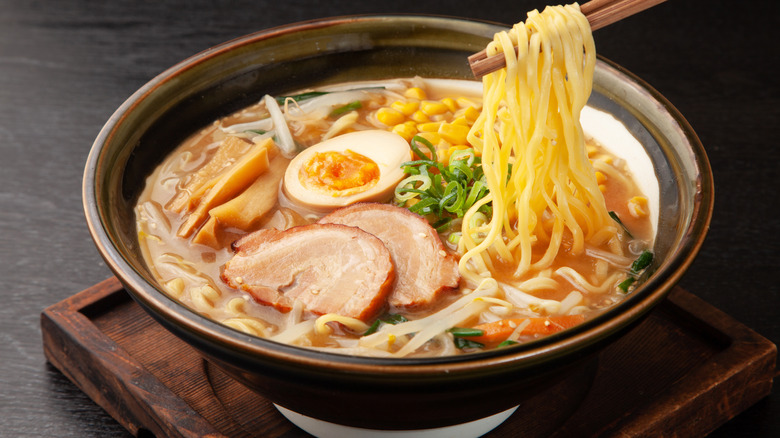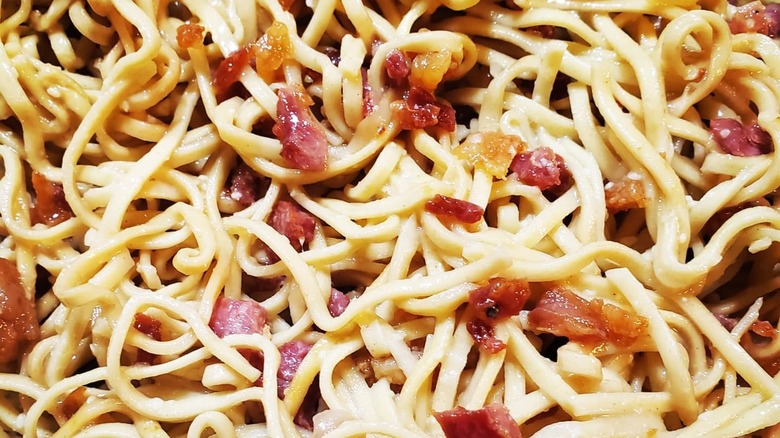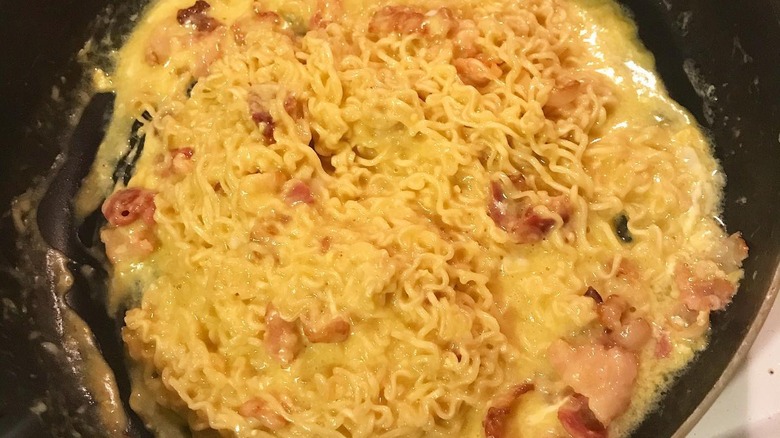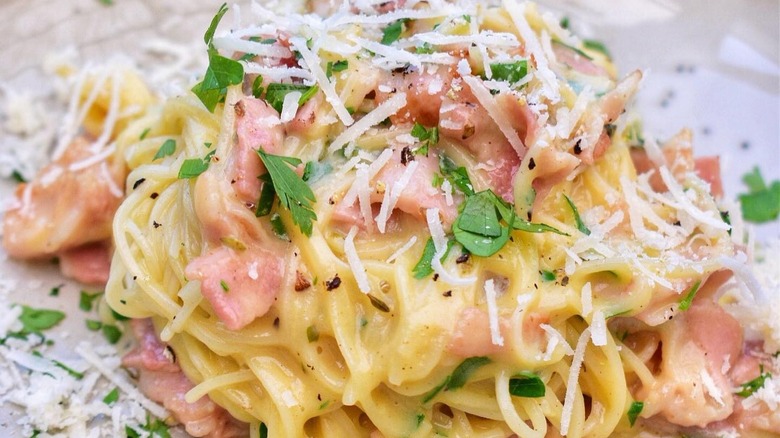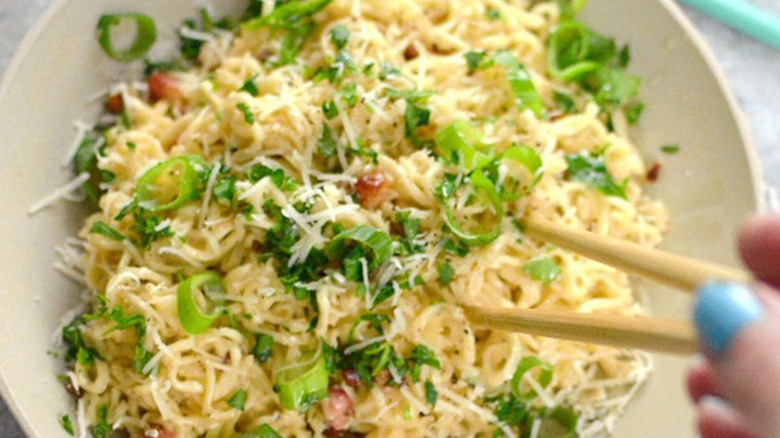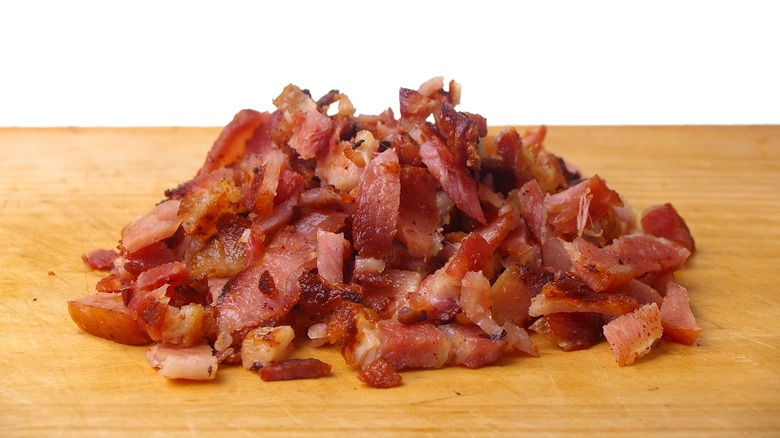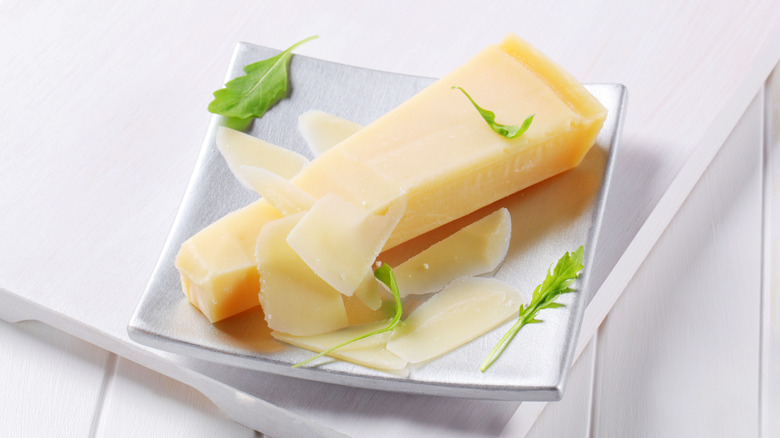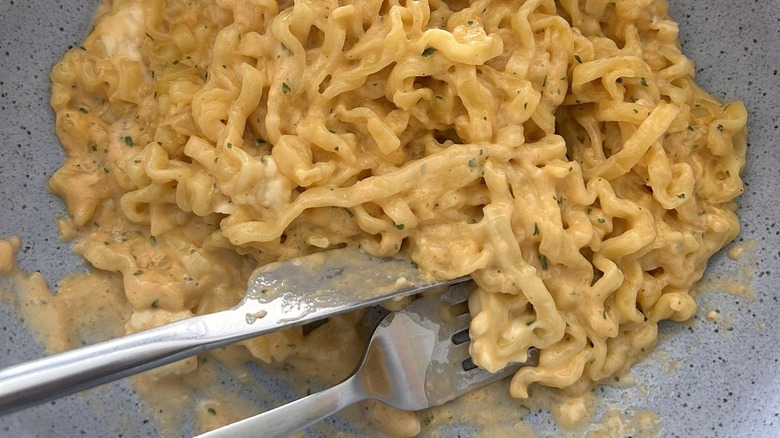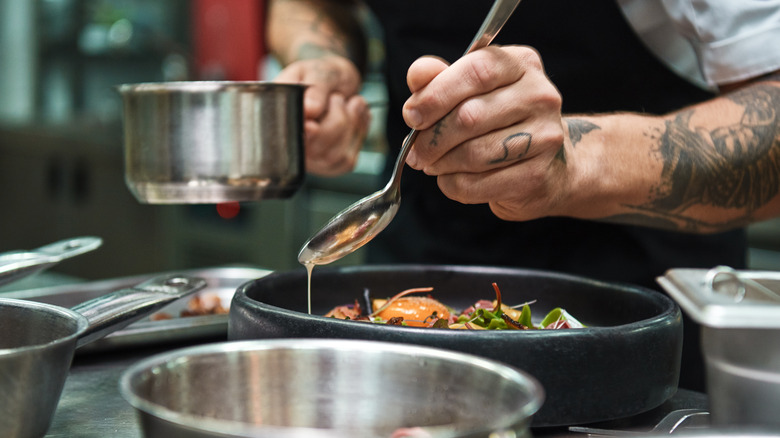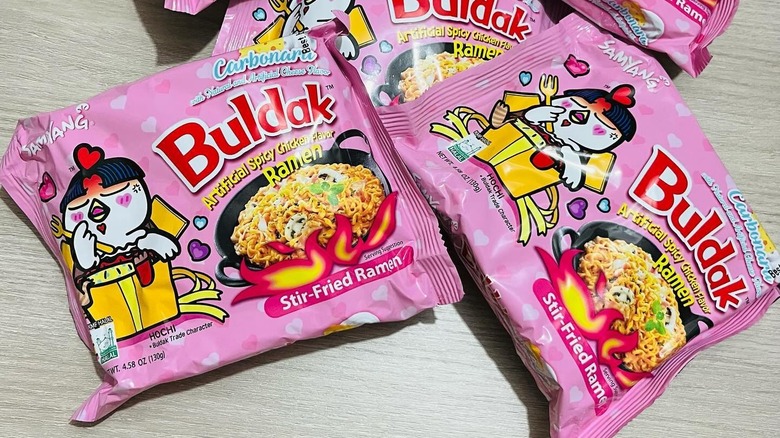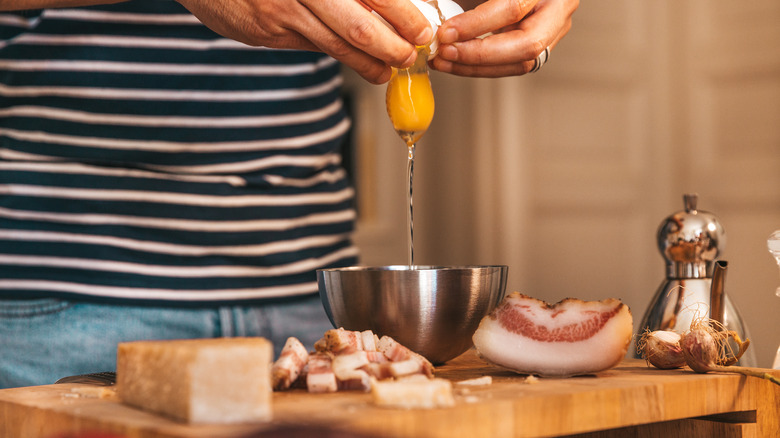What Is Ramen Carbonara And Is It As Good As They Say?
In the world of cooking, we often see unlikely traditions and flavors colliding, and a dish that's recently been making waves amongst foodie enthusiasts is no exception to this. Ramen carbonara, a marriage of the much-loved Japanese ramen and the iconic Italian carbonara, has been gaining the intrigue of adventurous home cooks and chefs alike. But what exactly is this unusual creation, and does it live up to the hype?
Ramen carbonara certainly defies convention, blending the rich, creamy textures of carbonara sauce with the thin, springy texture of ramen noodles. As this unique recipe idea has made its rounds on social media, it's earned plenty of praise while being met with some expected skepticism. Join us as we enter the world of ramen carbonara to explore its origins, dissect its key components, and assess its appeal. From its rise to fame to its potential pitfalls, we'll unravel the mysteries of this unique fusion of cuisines, and help you decide whether it's a must-try recipe or one best left avoided.
How did this dish rise to fame?
Thanks to the power of social media, ramen carbonara has had a recent rise to stardom, with this previously unheard-of fusion now capturing the imaginations of food enthusiasts worldwide. With the dawn of 2024, Ramen carbonara found itself in the spotlight, as Pinterest heralded it as part of the "Melty Mashups" food trend that's set to dominate the culinary scene this year. This ignited plenty of curiosity among foodies who were eager to try the next big thing.
The dish's popularity can be attributed to its widespread circulation online and across social media platforms, from videos of home cooks trying their hand at crafting the perfect ramen carbonara to the recipe being featured on popular websites and blogs. TikTok, in particular, is a haven for new food trends and where many users have showcased their own renditions of the dish.
However, before this recent boom in popularity, pre-packaged instant ramen was already available to buy in carbonara flavor. Instant noodle brand Samyang released their "Hot Chicken Flavor Ramen Carbonara" way back in December 2017, and Acecook unveiled a "Rich Carbonara-flavored Ramen" in early 2022. So, perhaps it was these convenient instant products that first sparked the idea to create a homemade version. Naturally, shop-bought ramen carbonara has also risen to fame online, with TikTok videos of users whipping up these instant noodles gaining millions of views.
What makes it like a carbonara?
At the heart of ramen carbonara, there's an unmistakable resemblance to the classic Italian pasta dish. Just like a traditional carbonara, the ramen version features a luxurious, creamy sauce that coats each noodle strand. The result is a comforting, indulgent dish that's full of savory flavor.
Traditional carbonara relies on just a handful of ingredients to build its rich flavors. It's typically made with eggs, cheese (usually Parmesan or pecorino), pancetta or guanciale, and black pepper, creating a sauce that is creamy without being overly heavy. And of course, this sauce is typically mixed with spaghetti. Ramen carbonara takes most of the features of the traditional sauce, though chopped bacon is more commonly used as an easy alternative to the harder-to-source Italian guanciale. However, when it comes to the pasta, this gets swapped out for instant ramen noodles, offering a completely different texture and vehicle for soaking up the salty, creamy flavors of the sauce.
What makes it like a ramen?
While ramen carbonara pays homage to the flavors and textures of traditional Italian carbonara, it seems a little further from a brothy bowlful of steaming ramen. The main characteristic that puts the "ramen" in ramen carbonara is generally just the use of instant ramen noodles in place of the classic spaghetti pasta.
One of the defining characteristics of ramen is its flavorful broth, which serves as the foundation of the dish. Whether it's a rich tonkotsu or a savory shoyu, ramen broth is known for its warming and umami-rich deliciousness. In ramen carbonara, the taste experience is very different. It's a creamy and luscious combination of ingredients, and while it may be equally indulgent and savory, there isn't much of a nod to traditional Japanese flavors or anything broth-like about it. Additionally, ramen is often served with a variety of toppings, ranging from slices of tender chashu pork to soft-boiled eggs, nori seaweed, and bamboo shoots. Ramen carbonara could of course be customized with an array of toppings, but we more typically see it served as is.
However, the use of ramen noodles in ramen carbonara does transform it into a completely unique creation. Prized for their springy texture and ability to soak up the flavors of the sauce, the noodles play a crucial role in shaping the overall eating experience into something that differs pretty wildly from tucking into a traditional Italian carbonara.
Why combine the two?
At first glance, the marriage of ramen noodles and carbonara might seem like a plan devised to anger Italian chefs and ramen connoisseurs. It could be argued that as standalone dishes, traditional ramen and carbonara are perfect just as they are. So, why exactly do we feel the need to combine these seemingly disparate recipes?
Well, there are actually plenty of reasons why this merging of recipes makes perfect sense. Each dish brings its own unique strengths to the table, resulting in a new creation that features the best of both. The fusion of ramen noodles and carbonara is a flavor and texture combination that works surprisingly well. Carbonara brings its creamy, savory richness, while ramen noodles give the ultimate chewiness. Made for soaking up broth, these noodles are usually made from wheat flour, water, salt, and kansui — an alkaline substance that helps to give them their unique firm yet springy texture.
Furthermore, the amalgamation of Japanese and Italian cuisine is not a novel concept. In Japan, "itameshi" has long been used to describe the culinary genre of Japanese-Italian fusion, which has become increasingly popular throughout the years. Itameshi cuisine often takes traditional Italian dishes such as pizza or ravioli and incorporates umami-rich Japanese flavors like soy sauce, miso, and seaweed. So, perhaps we're on to something with ramen carbonara!
Is it easy to make at home?
Those intrigued by the concept of ramen carbonara will be pleased to learn that making it at home is entirely achievable. This dish is wonderfully simple, and you might even have most of the ingredients in your kitchen already. The main components of ramen carbonara are eggs, Parmesan cheese, bacon, black pepper, and instant ramen noodles. Some recipes opt for other additions such as cream, garlic, herbs, or even the flavor packet from the instant noodles.
To prepare ramen carbonara at home, start by cooking your chosen noodles according to the package instructions. While these boil, whisk together eggs, grated cheese, and black pepper in a separate bowl to create the creamy sauce. In a pan, fry the chopped bacon until crispy and golden brown, then set aside. Once the noodles are cooked, drain and transfer them to the pan with the bacon, keeping the pan off the heat. Then, pour the egg and cheese mixture over the noodles, tossing to coat them evenly. The residual heat from the noodles will gently cook the eggs, creating a silky-smooth sauce. Finish with an extra sprinkle of cheese and another dash of freshly ground black pepper, and your homemade ramen carbonara is ready for the taste test.
What does it taste like?
Flavor-wise, ramen carbonara offers the same creamy, cheesy, and salty flavors as the classic Italian dish. The ramen noodle element doesn't provide a particularly strong flavor, but of course, alters the texture of the dish dramatically. When it comes to the meat, traditionalists would argue that guanciale is essential for getting that authentic carbonara taste. This is a cured meat made from pig cheeks, which is fatty and particularly flavorful. Ramen carbonara, however, generally features bacon. This gives the dish more of a smoky flavor.
While most ramen carbonara recipes opt for the use of Italian flavors only, some also like to incorporate that instant ramen taste. Along with the creamy egg and cheese-based sauce, there's also the option to add the flavor packet that comes with your instant ramen noodles. This can completely transform the taste of the dish, adding spice and deeper umami notes that blend with the creaminess for a truly unique flavor combination.
What can you serve it with?
Ramen carbonara makes for a great standalone dish, but its versatility means it pairs well with plenty of side dishes. Whether you want to amp up the comfort factor or add a touch of freshness, there are a variety of options to consider.
Firstly, to keep things simple and lean into the Italian theme, serve your ramen carbonara with some garlic bread. The crispy, golden slices are perfect for mopping up that creamy sauce. Or for something more fresh, a crisp salad with lettuce and tomatoes adds a palate-cleansing contrast to the rich ramen carbonara. A scattering of chopped green onions or fresh herbs on top of the saucy noodles can go a long way.
If you're looking to add some hearty goodness to your plate, serve with an assortment of sautéed veggies such as mushrooms, zucchini, bell peppers, and broccoli. This adds an extra element to the meal that's both satisfying and nutritious. You could also take a Japanese-inspired approach to your ramen carbonara pairings. Tangy pickled vegetables, such as radishes, cucumber, and red onions, can bring a hint of acidity that cuts through the richness of the dish.
When it comes to drinks, ramen carbonara would pair wonderfully with a glass of crisp white wine or a cold beer. Or for a non-alcoholic alternative, try something light and fresh, like an elderflower cordial or fizzy lemonade.
Is it healthy?
Ramen carbonara might be a delicious, fun, and unique new dish to try, but it is probably best enjoyed as an occasional treat. It's not considered a healthy dish in the traditional sense, primarily due to its high fat and calorie content.
On one hand, ramen carbonara can be a source of essential nutrients. It features protein-packed bacon and vitamin-rich eggs, with ramen noodles bringing the carb element that is essential to any balanced meal. However, the bacon, eggs, and cheese are particularly heavy on saturated fat. While these ingredients undoubtedly add to the dish's decadent appeal, they can also contribute to health concerns such as elevated cholesterol levels and increase the risk of developing heart disease. Though providing bite and sustenance, ramen noodles are not particularly rich in nutrients, while being fairly low in fiber, so don't pack much of a healthful punch either.
That said, there are ways to make ramen carbonara healthier. You could opt for a leaner cut of bacon and trim away the excess fat before adding it to the pan, as well as reducing the amount of cheese used in the sauce. Incorporating vegetables into the dish can boost the nutrition factor. Try sautéing diced onion, mushrooms, peas, or corn with the bacon for some extra goodness. So, while ramen carbonara may not be the epitome of healthy food, it can certainly be enjoyed as part of a balanced diet.
Is it expensive to make?
The cost of making this dish can of course vary depending on factors such as ingredient quality and location. But, overall, ramen carbonara is a pretty economical recipe to whip up. Most of the essential components — eggs, bacon, and ramen noodles — are generally affordable and widely available. If you're opting for a premium brand or cut of bacon, this might up your costs a little.
A more significant expense in making ramen carbonara may be the Parmesan or pecorino cheese. A high-quality variety can be relatively pricey. However, buying a block of cheese rather than a pre-grated version can reduce costs. Alternatively, using a combination of Parmesan and a more affordable cheese, such as Grana Padano or even cheddar, can be another money-saving hack.
The pancetta or guanciale often called for in a traditional Italian carbonara is usually more costly and difficult to source than bacon. Similarly, Japanese ramen usually features a wider array of components and toppings, meaning your ingredient expenses can quickly rack up. So, cooking up this simple fusion of the two classics is not just a fun exploration of flavors and textures; it can save you money, too!
How do people rate it?
As to be expected with any new ideas in the foodie world, there are mixed opinions on the unique fusion that is ramen carbonara. Some love this creamy, noodle-based creation, while others see it as an insult to the Italian classic.
In one Reddit thread where the poster added a photo of their ramen carbonara creation, there were some very positive reactions, with one commenter asking, "How do I make this gift from the gods?". Over on TikTok, the creator is happily slurping up the finished dish, exclaiming, "Now I see why this is the next big food trend of 2024".
However, the rise of ramen carbonara has also been met with some skepticism. In another ramen carbonara Reddit thread, the views of one carbonara purist were clear. "I'm screaming inside and my nonna just fainted," they commented. Furthermore, when chef Phil Vickery made the dish on the U.K. television show "This Morning", all hell broke loose on X, formerly known as Twitter. One viewer's thoughts were "Carbonara/ramen? What fresh hell is this[?]", while another asked, "What is that? Vomit sandwich??". Despite this, when "This Morning" host Rylan Clark tasted the dish, he appeared to enjoy it, claiming that noodles "take on the flavour better than pasta".
Can you find this in any restaurants?
Carbonara and ramen are of course two dishes that are readily available in restaurants all over the world. However, you may be hard-pressed to find ramen carbonara on the menu. As it's neither authentic to the Italian classic nor traditional ramen, it doesn't fit fully into one type of cuisine.
However, we found two restaurants serving their own takes on this unique dish. pastaRAMEN, in Montclair, New Jersey, describes itself as "the first-ever Italian ramen shop" and "a perfect marriage of Japanese and Italian culture and cuisine." And sitting proudly on the menu is their Mochi Ramen Carbonara Tsukemen. This indulgent recipe differs slightly from the homemade version doing the rounds online, with the sauce featuring lemon and togarashi — a spicy and zesty Japanese seasoning. For ultimate effect, the sauce is also poured over the cheesy noodles at the table as the dish is served.
Ramen Lab Eatery in Florida also features Carbonara Ramen on its menu, alongside more traditional Japanese dishes like donburi and poke bowls. A glowing review on the restaurant's website states "The carbonara ramen is delicious!". We're not sure if this one takes more of a brothy ramen angle, but we'd be intrigued to try their interpretation.
What about the pre-packaged version?
If you're seeking an easy store-bought alternative to homemade ramen carbonara, Samyang's Hot Chicken Ramen in the Carbonara flavor is a great option to try. Samyang is a well-known Korean brand renowned for its fiery hot chicken ramen, and it expanded its repertoire to include a carbonara-flavored version of its popular instant noodles back in 2017.
Samyang's carbonara noodles are quite different from most homemade ramen carbonara recipes, which focus more heavily on Italian-inspired flavors. This pre-packaged version also features a creamy sauce, but this is infused with the signature spicy heat that the brand is famous for. The noodles come packed with a separate powdered seasoning packet containing the carbonara element, as well as a sauce packet to add spice and flavor. These instant noodles can be found in many Asian grocery stores and online retailers.
One of the advantages of the store-bought version is its convenience. Prepping these instant noodles is indeed a super speedy process. Simply boil the noodles until tender, drain them, and mix in the sauce and seasoning packet. The result is an indulgent dish that combines the rich creaminess of carbonara with the fiery kick of Samyang's ramen. But with a powder replacing the fresh carbonara ingredients like egg and cheese here, you might prefer to make the dish from scratch for a more wholesome experience.
Should I just make ramen or carbonara instead?
It's easy to turn your nose up at an idea that brings two completely different dishes together in a seemingly strange fusion. For the purists, there may be no convincing here. However, we believe ramen carbonara has earned its place in the foodie spotlight for good reason.
If you're looking for the iconic umami flavors, savory broth, and variety of toppings that come with a comforting bowl of traditional ramen, steer clear of ramen carbonara. After all, the only element it really seems to take from the Japanese classic is the ramen noodles. Additionally, if you're craving the indulgent richness of an authentic carbonara, with perfectly al dente spaghetti, the classic Italian dish is what you should go for.
Rather than being seen as a replacement for either of these dishes, we think it should be viewed as something separate. Ramen carbonara is a dish in its own right — a fun and simplified take on Italian carbonara, with a whole new texture provided by those springy noodles. It can't be described as authentic or traditional, but the flavors are still delicious and the unlikely combination of different elements actually works pretty well together. Whether you love or hate the idea of this dish, you have to credit its creativity. So, will you be giving ramen carbonara a try?
